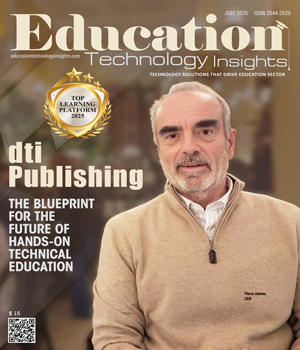THANK YOU FOR SUBSCRIBING
Be first to read the latest tech news, Industry Leader's Insights, and CIO interviews of medium and large enterprises exclusively from Education Technology Insights
Using Technology to Deepen Human Connection in Online Education
Jean Mandernach, Executive Director, Center for Innovation in Research and Teaching, Grand Canyon University
 Jean Mandernach, Executive Director, Center for Innovation in Research and Teaching, Grand Canyon University
Jean Mandernach, Executive Director, Center for Innovation in Research and Teaching, Grand Canyon UniversityImagine a world where AI handles your grading, creates your course content and manages routine student questions—all while you sleep. This isn't science fiction; it's education in 2025. But the pressing question isn't whether AI can automate these tasks—it's what we'll do with the hours we reclaim.
The data is compelling: when human connection diminishes in online education, so does student success. Retention drops (Tinto, 2018), critical thinking skills are impaired (Akyol & Garrison, 2011) and student satisfaction decreases (Richardson et al., 2017). Yet many institutions adopting AI focus solely on efficiency metrics without addressing the fundamental challenge: “How can faculty reinvest this newfound time to strengthen the interpersonal dimensions of learning that no algorithm can replicate?”
The Community of Inquiry framework (Garrison et al., 2000) reminds us that effective online education requires both cognitive and teaching presence and social presence—the ability of participants to identify with the community and develop meaningful relationships. As AI takes over routine tasks, faculty must be more visible, accessible and personally invested in the learning journey. Faculty have an unprecedented opportunity to strengthen this critical social dimension through intentional practices that technology cannot replicate.
Practical Strategies for Humanizing Online Learning
Here are concrete ways faculty can reinvest time saved through AI to enhance human connection in education:
Personalized Feedback and Coaching
• Individual Video Feedback: Record two- to three-minute personalized videos on major assignments. Address students by name, highlight specific strengths in their work and offer targeted suggestions. These videos allow students to see facial expressions and hear tone, making feedback feel more personal than text comments alone.
“When human connection diminishes in online education, so does student success—retention drops, critical thinking weakens, and satisfaction decreases, making social engagement essential for long-term academic outcomes and student well-being”
• Voice Notes for Formative Assessment: Send brief 30—to 60-second audio feedback on draft submissions or discussion posts. The nuance of spoken feedback helps students understand what to improve and conveys your investment in their progress.
• Learning Path Consultations: Schedule quarterly 15-minute video calls with each student focused on their academic journey. Use these conversations to help students identify patterns in their work, connect course concepts to their professional goals and develop personalized learning strategies.
Community Building Activities
• Rotating Small Group Sessions: Host weekly, optional small group video discussions. Create a sign-up sheet where students select timeslots that work for them. The intimate setting encourages quieter students to participate and builds peer connections.
• Virtual Office Hours with Purpose: Transform standard office hours into themed sessions with specific focus areas—"Concept Clarification Mondays" or "Application Workshops Wednesdays." Communicate the theme in advance and prepare targeted activities.
• Student-Faculty Coffee Chats: Schedule informal 15-minute virtual coffee meetings with a few students periodically throughout the term. Unlike content-focused office hours, these sessions explicitly focus on getting to know students as people.
Content Personalization
• Tailored Resource Curation: Create custom resource collections for different student interests or career paths. Share these with personal notes explaining why you thought specific resources would align with their interests.
• Just-in-Time Mini-Lessons: Create brief three to five-minute video or audio explanations addressing common confusion points identified from student work or questions.
• Interest-Based Content Extensions: Based on discussion posts or assignment choices, send personalized recommendations for optional "deep dive" resources aligning with students' interests.
Authentic Assessment Opportunities
 • Individual Assessment Redesign: Work with students to customize assessment options that align with their interests and career goals while meeting core learning objectives. Allow students to propose alternative formats or contexts.
• Individual Assessment Redesign: Work with students to customize assessment options that align with their interests and career goals while meeting core learning objectives. Allow students to propose alternative formats or contexts.
• Real-Time Assessment Conversations: Replace some traditional written assessments with video-based dialogues where students explain and defend their understanding. This approach reduces plagiarism while giving direct insight into students' thinking processes.
• Collaborative Problem-Solving Sessions: Facilitate small-group problem-solving sessions where students work together on complex scenarios while you observe and provide coaching. Your real-time guidance helps students correct misconceptions immediately.
Presence and Responsiveness Enhancement
• Personalized Outreach: Create individualized video or audio messages for students at key points in the term. Address students by name and reference specific aspects of their work or participation.
• Weekly Reflection Prompts: Send personalized, thought-provoking questions to students based on their recent work or contributions. For example, "I noticed your interest in X concept—have you considered how it might connect to your work in Y?" These brief prompts demonstrate your attentiveness to their intellectual journey and encourage deeper engagement with course material.
• Regular Wellness Check-ins: Create brief, structured opportunities for students to share challenges they're facing. Follow up personally with any student indicating significant obstacles, offering resources or adjustments as needed.
Moving Forward
The most successful integration of AI in education will be where technology enhances rather than diminishes human connection. Faculty should view AI not as a replacement for their expertise but as a tool that frees them to focus on the interpersonal dimensions of teaching that technology cannot replicate.
By implementing even a few of these concrete strategies, faculty can ensure that AI humanizes rather than mechanizes the educational experience. The future of education lies not in technology that replaces faculty but in technology that empowers faculty to connect with students in more meaningful ways than ever before.
Read Also
Our AI Crisis isn't Technical. It's Human.
4 Keys to Managing Change
Active Engagement is the Foundation of Effective Leadership
Empowering Leadership through Innovation in Higher Education
Redefining Readiness: A Path Toward a Technology-Agnostic Future
The New Era of Education

I agree We use cookies on this website to enhance your user experience. By clicking any link on this page you are giving your consent for us to set cookies. More info

However, if you would like to share the information in this article, you may use the link below:
www.educationtechnologyinsightsapac.com/cxoinsights/jean-mandernach-nid-3169.html


















